Experimental Study of Recycled Concrete under Freeze–Thaw Conditions
Abstract
:1. Introduction
2. Purpose and Scope of the Research
3. Experimental Program
3.1. Material
3.2. Design of Concrete Mix Ratio
3.3. Preparation of Recycled Aggregates
3.4. Recycled Concrete Preparation
3.5. Slump Test of Recycled Concrete
3.6. Freeze–Thaw Cycles
3.7. Rebound Value Test
3.8. Compressive Strength Test
3.9. Recycled Concrete Quality Loss Test
4. Results and Discussion
4.1. The Workability of Recycled Concrete
4.2. Rebound Values
4.3. Changes in Quality Loss
4.4. Compressive Strength
5. Enhanced Performance of Recycled Concrete
6. Conclusions
- As the replacement rate of recycled aggregate increases, the workability of recycled concrete is negatively impacted. The slump of concrete mixed with 100% recycled coarse aggregate decreased by 21 mm compared to concrete without recycled coarse aggregate. This is primarily attributed to numerous pore cracks on the surface of recycled aggregate, along with its high water absorption, subpar surface roughness, and limited fluidity.
- The rebound value of recycled concrete tends to decrease as the rate of recycled substitution increases. The maximum attenuation of rebound value is 8 mm. After 30 freeze–thaw cycles, the rebound value of concrete mixed with 50% recycled coarse aggregate decreased by 8 mm. When the replacement rate of recycled aggregate is less than 50%, the loss of rebound value is not severe, and the performance of recycled concrete is good. Therefore, when using recycled concrete in cold regions, the amount of waste mortar on recycled aggregates should be minimized as much as possible. When the recycled coarse aggregate does not exceed 50%, the concrete exhibits good performance.
- The higher the number of freeze–thaw cycle, the higher the rate of quality loss. However, the overall quality loss is not severe, with only a slight detachment of the surface concrete.
- When the replacement rate of recycled coarse aggregate exceeds 75%, the compressive strength of the concrete decreases significantly. In practical applications, it is not advisable to use too much recycled aggregate. The influence of the replacement rate of recycled aggregates on strength becomes sensitive as the degree of freeze–thaw cycles increases. Therefore, when using recycled concrete in particularly cold places, the substitution rate of recycled coarse aggregates should be reduced to achieve good mechanical properties.
- The strength and lifespan of recycled concrete can be enhanced through various methods such as heat treatment, chemical treatment, or the addition of organic materials or other solvents to the recycled aggregate.
Author Contributions
Funding
Institutional Review Board Statement
Informed Consent Statement
Data Availability Statement
Conflicts of Interest
References
- Arezoumandi, M.; Drury, J.; Volz, J.S. Effect of Recycled Concrete Aggregate Replacement Level on Shear Strength of Reinforced Concrete Beams. ACI Mater. J. 2015, 112, 559–567. [Google Scholar]
- Yang, Y.; Lu, P.; Shao, R. A comprehensive review of multisource solid wastes in sustainable concrete: From material properties to engineering application. Constr. Build. Mater. 2024, 435, 136775. [Google Scholar]
- Chandru, U.; Bahurudeen, A.; Senthilkumar, R. Systematic comparison of different recycled fine aggregates from construction and demolition wastes in OPC concrete and PPC concrete. J. Build. Eng. 2023, 75, 106768. [Google Scholar]
- Wu, J.; Jing, X.H.; Wang, Z. Uni-axial compressive stress-strain relation of recycled coarse aggregate concrete after freezing and thawing cycles. Constr. Build. Mater. 2017, 134, 210–219. [Google Scholar]
- Powers, T.C. A working hypothesis for further studies of frost resistance of concrete. ACI J. Proc. 1945, 41, 245–272. [Google Scholar]
- Powers, T.C. Air requirement of frost-resistant concrete. Highw. Res. Board Proc. 1950, 29, 184–202. [Google Scholar]
- Powers, T.C. Void space as a basis for producing air-entrained concrete. ACI J. Proc. 1954, 50, 741–760. [Google Scholar]
- Powers, T.C. Helmuth R A. Theory of volume changes in hardened port land-cement paste during freezing. Highw. Res. Board Proc. 1953, 32, 285–297. [Google Scholar]
- Li, T.Y. Discussion on the mechanism of concrete frost damage—The effect of hydrostatic pressure and osmotic pressure. Concr. Cem. Prod. Prod. 1989, 8–11. [Google Scholar]
- Litvan, G.G. Phase Transitions of Adsorbates. III. Heat effects and dimensional changes in nonequilibrium temperature cycles. J. Colloid Interface Sci. 1972, 38, 75–83. [Google Scholar] [CrossRef]
- Litvan, G.G. Phase Transitions of Adsorbates: IV, Mechanism of Frost Action in Hardened Cement Paste. J. Am. Ceram. Soc. 1972, 55, 38–42. [Google Scholar] [CrossRef]
- Fagerlund, G. The Signifcance of Critical Degrees of Saturation at Freezing of Porous and Brittle Materials. ACI Spec. Publ. 1975, 47, 13–66. [Google Scholar]
- Chen, T.C.; Yeung, M.R.; Mori, N. Effect of water saturation on deterioration of welded tuff due to freeze-thaw action. Cold Reg. Sci. Technol. 2004, 38, 127–136. [Google Scholar] [CrossRef]
- Penttala, V. Freezing-Induced Strains and Pressures in Wet Porous Materials and Especially in Concrete Mortars. Adv. Cem. Based Mater. 1998, 7, 8–19. [Google Scholar] [CrossRef]
- Setzer, M.J. Micro-ice-lens formation in porous solid. J. Colloid Interface Sci. 2001, 243, 193–201. [Google Scholar] [CrossRef]
- Kaufmann, J.P. Experimental identification of ice formation in small concrete pores. Cem. Concr. Res. 2004, 34, 1421–1427. [Google Scholar] [CrossRef]
- Mu, R.; Tian, W.L.; Zhou, M.J. Moisture migration in concrete under freeze-thaw cycle conditions. J. Ceram. 2010, 38, 1713–1717. [Google Scholar]
- Zaharieva, R.; Buyle, F.; Wirquin, E. Frost resistance of recycled aggregate concrete. Cem. Concr. Res. 2004, 34, 1927–1932. [Google Scholar] [CrossRef]
- Su, T.; Wu, J.; Yang, G. Bond behavior between recycled coarse aggregate concrete and steel bar after salt-frost cycles. Constr. Build. Mater. 2019, 226, 673–685. [Google Scholar] [CrossRef]
- Lotf, M.A.; Ramezanianpour, A.M.; Palassi, M. Evaluating the Frost Resistance of Recycled Concrete Aggregate by Various Standards. J. Mater. Civ. Eng. 2018, 30, 04018117. [Google Scholar] [CrossRef]
- Omary, S.; Ghorbel, E.; Wardeh, G. Relationships between recycled concrete aggregates characteristics and recycled aggregates concretes properties. Constr. Build. Mater. 2016, 108, 163–174. [Google Scholar] [CrossRef]
- Wei, D.; Zhu, P.; Yan, X. Potential evaluation of waste recycled aggregate concrete for structural concrete aggregate from freeze-thaw environment. Constr. Build. Mater. 2022, 321, 126291. [Google Scholar] [CrossRef]
- Buck, A.D. Recycled Concrete as a Source of Aggregate. J. Proc. 1977, 74, 212–219. [Google Scholar]
- Salem, R.M.; Burdette, E.G. Role of chemical and mineral admixtures on physical properties and frost-resistance of recycled aggregate concrete. ACI Mater. J. 1998, 95, 558–563. [Google Scholar]
- Yildirim, S.T.; Meyer, C.; Herfellner, S. Effects of internal curing on the strength, drying shrinkage and freeze–thaw resistance of concrete containing recycled concrete aggregates. Constr. Build. Mater. 2015, 91, 288–296. [Google Scholar] [CrossRef]
- Cao, W.L.; Liang, M.B.; Dong, H.Y. Experimental study on basic mechanical properties of recycled concrete after freezing and thawing. J. Nat. Hazards 2012, 21, 184–190. [Google Scholar]
- Fan, Y. Experimental study on the effect of freeze-thaw cycles on the mechanical properties of frost-resistant recycled aggregate concrete. Ph.D. Thesis, Harbin Institute of Technology, Harbin, China, 2009. [Google Scholar]
- Thomas, C.; Setién, J.; Polanco, J.A. Durability of recycled aggregate concrete. Constr. Build. Mater. 2013, 40, 1054–1065. [Google Scholar] [CrossRef]
- Ohemeng, E.A.; Ekolu, S.O.; Quainoo, H. Models for predicting strength properties of recycled concretes made with non-treated CRCAs: Empirical approach. Constr. Build. Mater. 2021, 307, 124585. [Google Scholar] [CrossRef]
- JGJ 55-2011; Specification for Mix Proportion Design of Ordinary Concrete. China Architecture & Building Publishing House: Beijing, China, 2011.
- GB/T 50082-2009; Chinese National Standard, Standard for Test Methods of Long Term Performance and Durability of Ordinary Concrete. General Administration of Quality Supervision, Inspection and Quarantine of the People‘s Republic of China: Beijing, China, 2009.
- GBT50081-2002; Chinese National Standard, Standard for Test Method of Mechanical Properties on Ordinary Concrete. General Administration of Quality Supervision, Inspection and Quarantine of the People‘s Republic of China: Beijing, China, 2003.
- Scrivener, K.L.; Crumbie, A.K.; Laugesen, P. The interfacial transition zone (ITZ) between cement paste and aggregate in concrete. Interface Sci. 2004, 12, 411–421. [Google Scholar] [CrossRef]
- Park, W.; Noguchi, T. Influence of metal impurity on recycled aggregate concrete and inspection method for aluminum impurity. Constr. Build. Mater. 2013, 40, 1174–1183. [Google Scholar] [CrossRef]
- Guo, H.; Shi, C.; Guan, X. Durability of recycled aggregate concrete—A review. Cem. Concr. Compos. 2018, 89, 251–259. [Google Scholar] [CrossRef]
- Katz, A. Properties of concrete made with recycled aggregate from partially hydrated old concrete. Cem. Concr. Res. 2003, 33, 703–711. [Google Scholar] [CrossRef]
- Tam, V.; Gao, X.F.; Tam, C.M. Microstructural analysis of recycled aggregate concrete produced from two-stage mixing approach. Cem. Concr. Res. 2005, 35, 1195–1203. [Google Scholar] [CrossRef]
- Choi, H.; Choi, H.; Lim, M. Evaluation on the Mechanical Performance of Low-Quality Recycled Aggregate Through Interface Enhancement Between Cement Matrix and Coarse Aggregate by Surface Modification Technology. Int. J. Concr. Struct. Mater. 2016, 10, 87–97. [Google Scholar] [CrossRef]
- Dimitriou, G.; Savva, P.; Petrou, M.F. Enhancing mechanical and durability properties of recycled aggregate concrete. Constr. Build. Mater. 2018, 158, 228–235. [Google Scholar] [CrossRef]
- Koshiro, Y.; Ichise, K. Application of entire concrete waste reuse model to produce recycled aggregate class. Constr. Build. Mater. 2014, 67, 308–314. [Google Scholar] [CrossRef]
- Kim, H.S.; Kim, J.M.; Kim, B. Quality improvement of recycled fine aggregate using steel ball with the help of acid treatment. J. Mater. Cycles Waste Manag. 2018, 20, 754–765. [Google Scholar] [CrossRef]
- Shigeishi, M. Separation and collection of coarse aggregate from waste concrete by electric pulsed power. AIP Conf. Proc. 2017, 1887, 020077. [Google Scholar]
- Kim, J. Influence of quality of recycled aggregates on the mechanical properties of recycled aggregate concretes: An overview. Constr. Build. Mater. 2022, 328, 127071. [Google Scholar] [CrossRef]
- Chinzorigt, G.; Lim, M.K.; Yu, M. Strength, shrinkage and creep and durability aspects of concrete including CO2 treated recycled fine aggregate. Cem. Concr. Res. 2020, 136, 106062. [Google Scholar] [CrossRef]
- Feng, Z.Y.; Zhao, Y.X.; Zeng, W.L. Using microbial carbonate precipitation to improve the properties of recycled fine aggregate and mortar. Constr. Build. Mater. 2020, 230, 116949. [Google Scholar] [CrossRef]

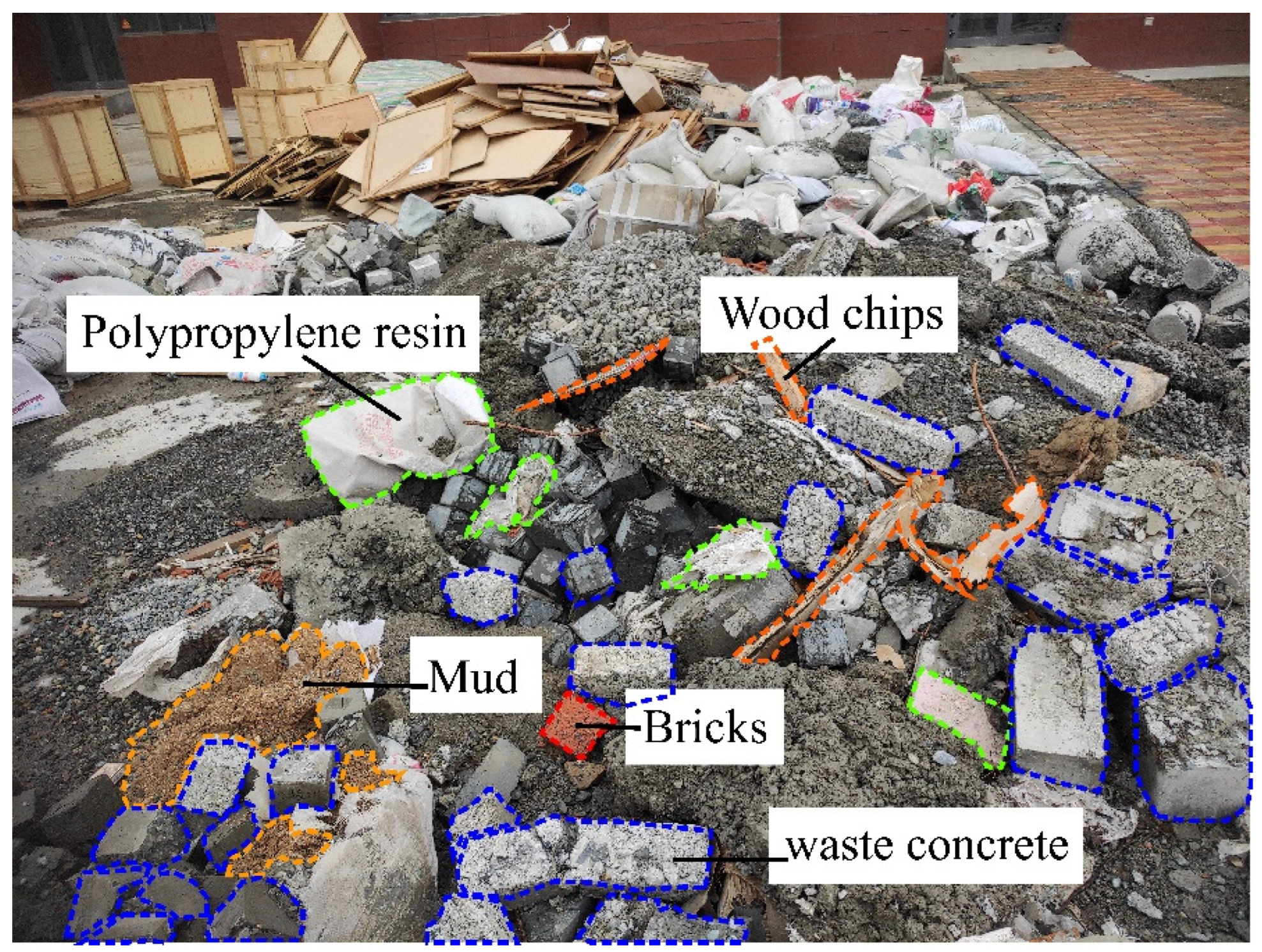
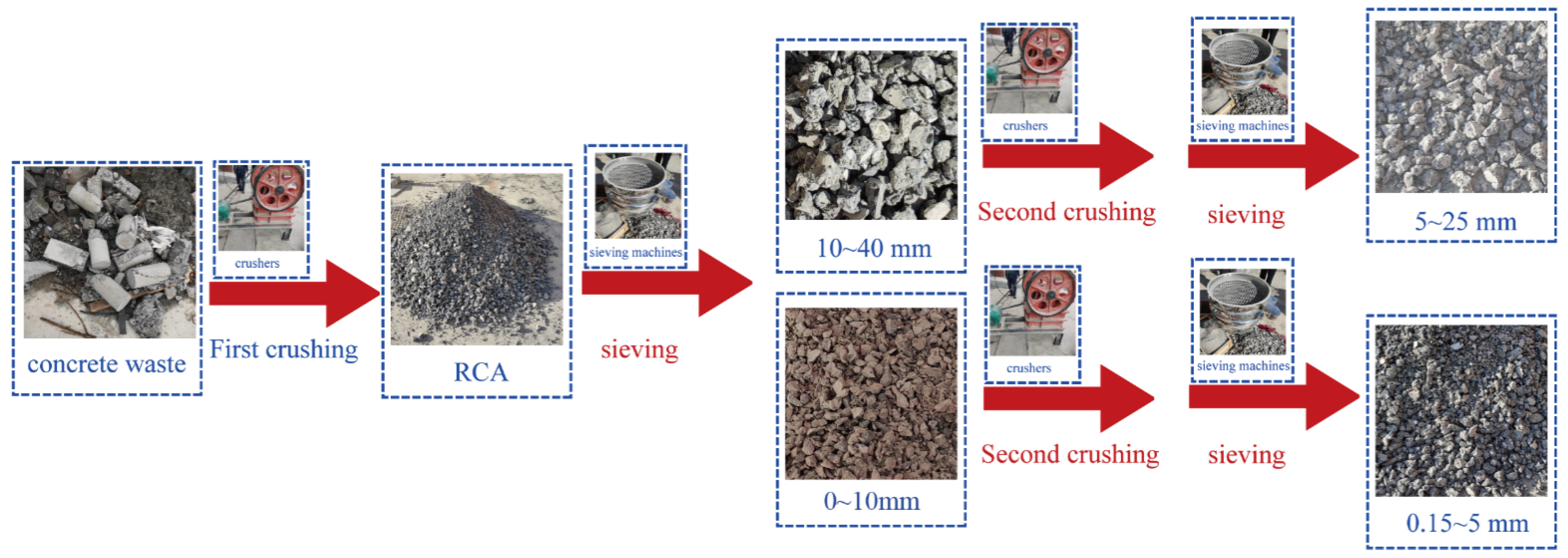
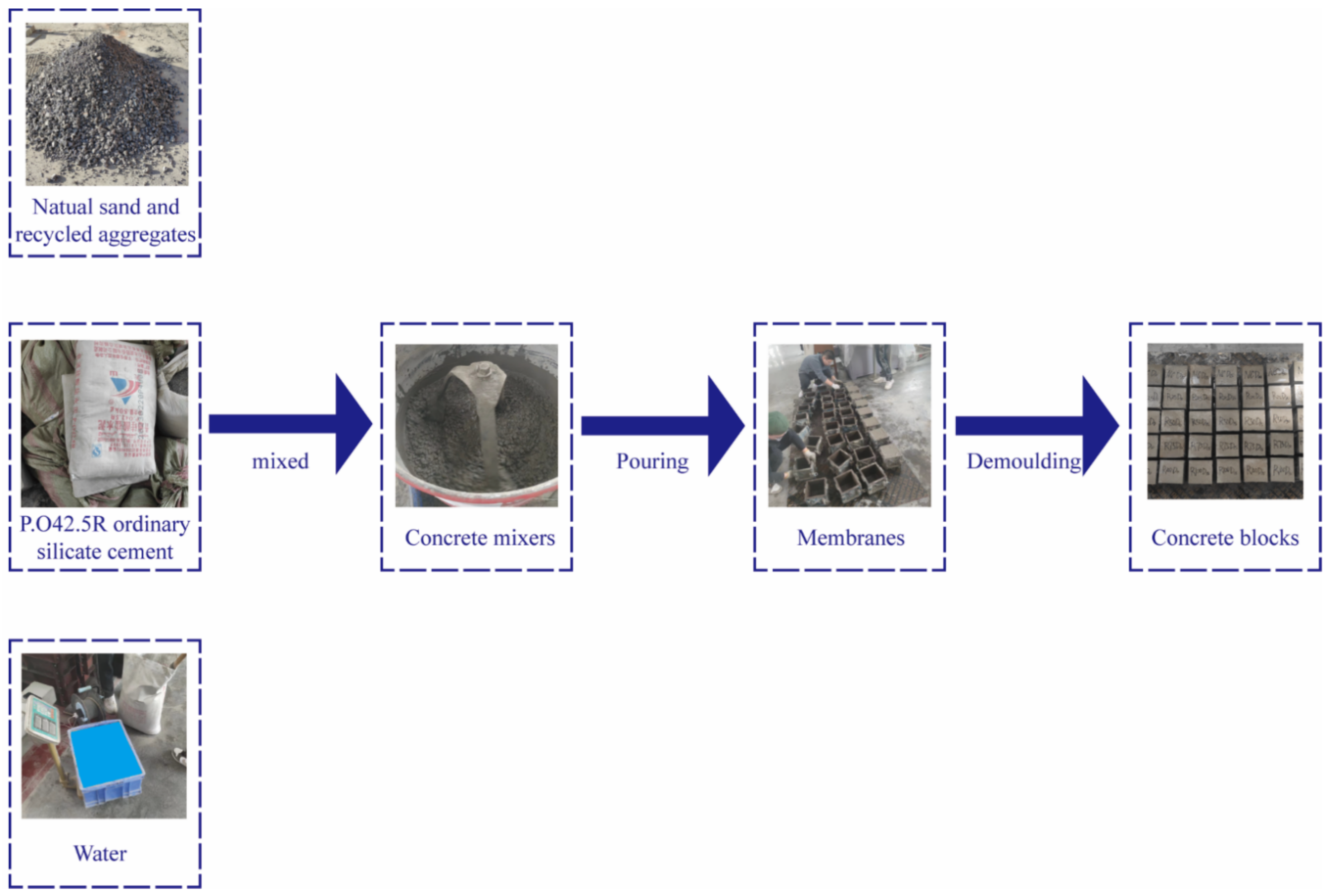

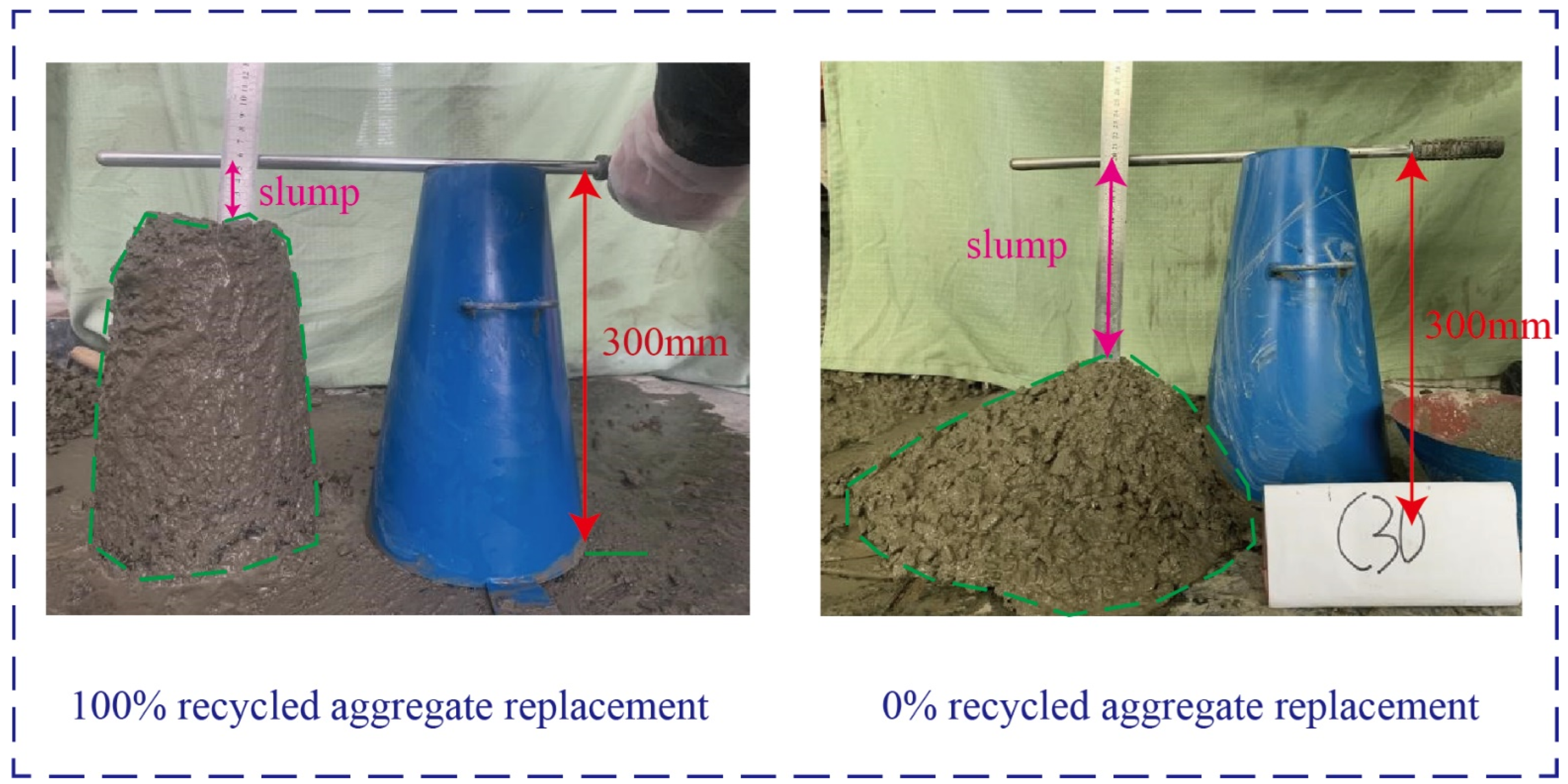

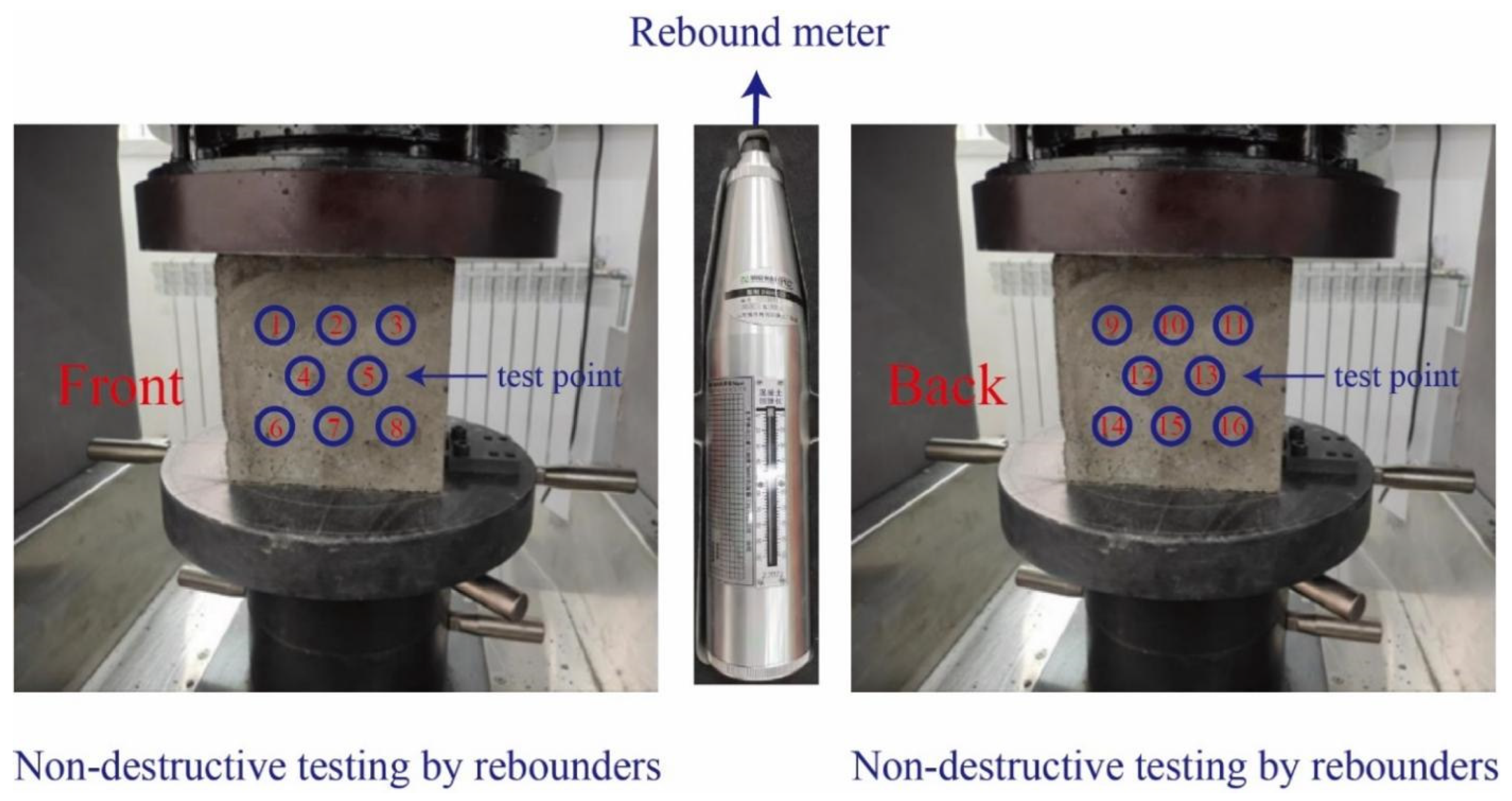

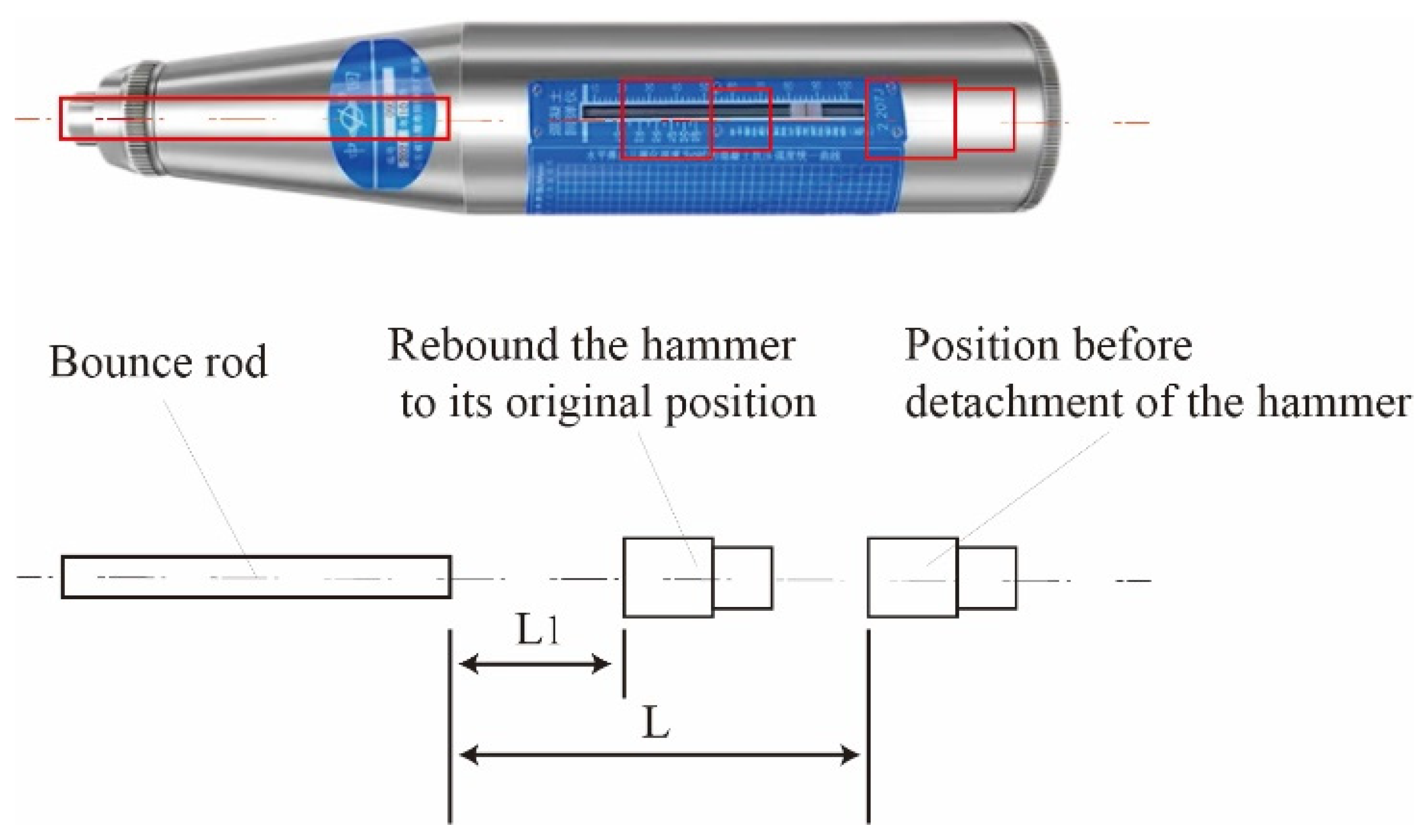
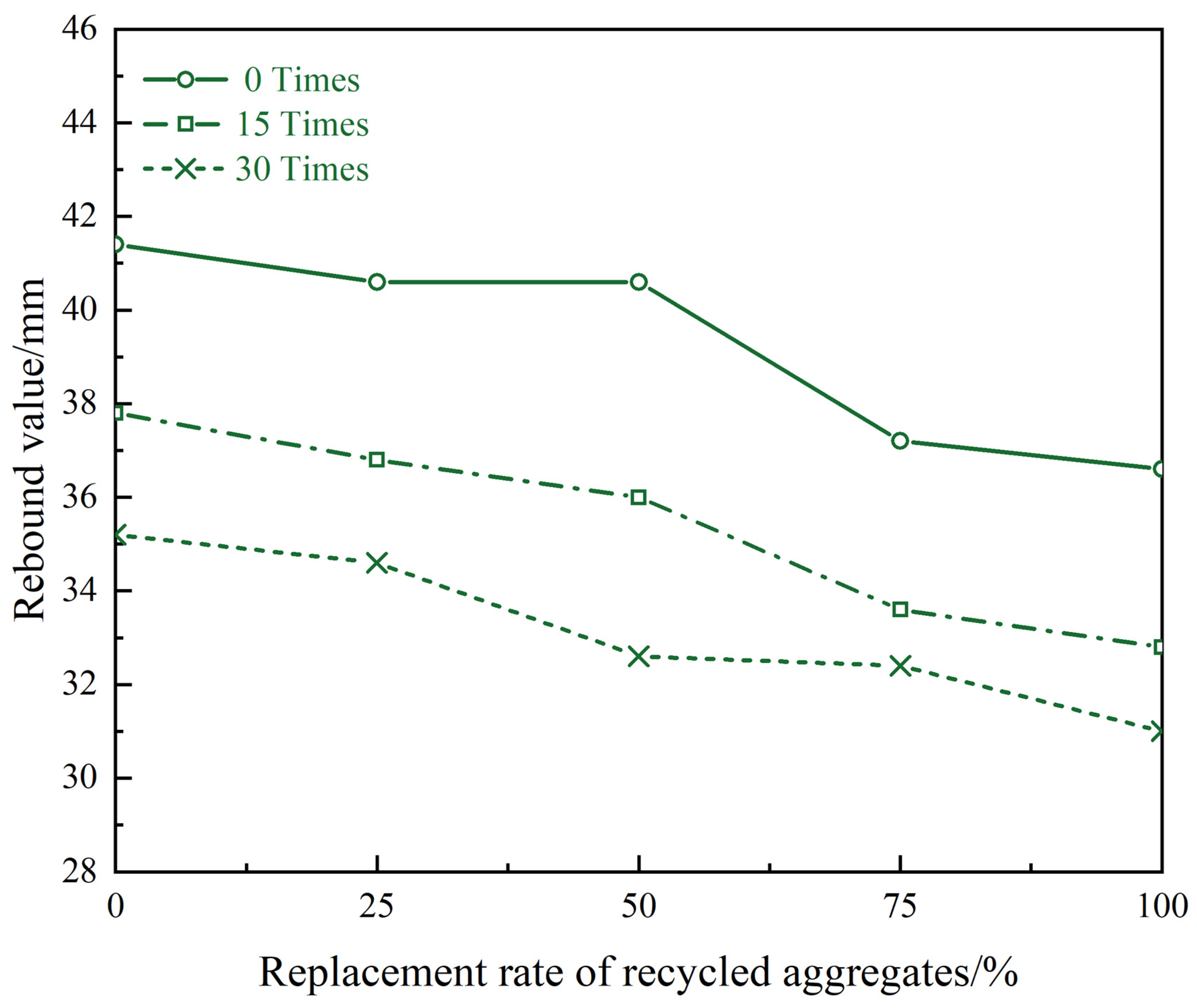


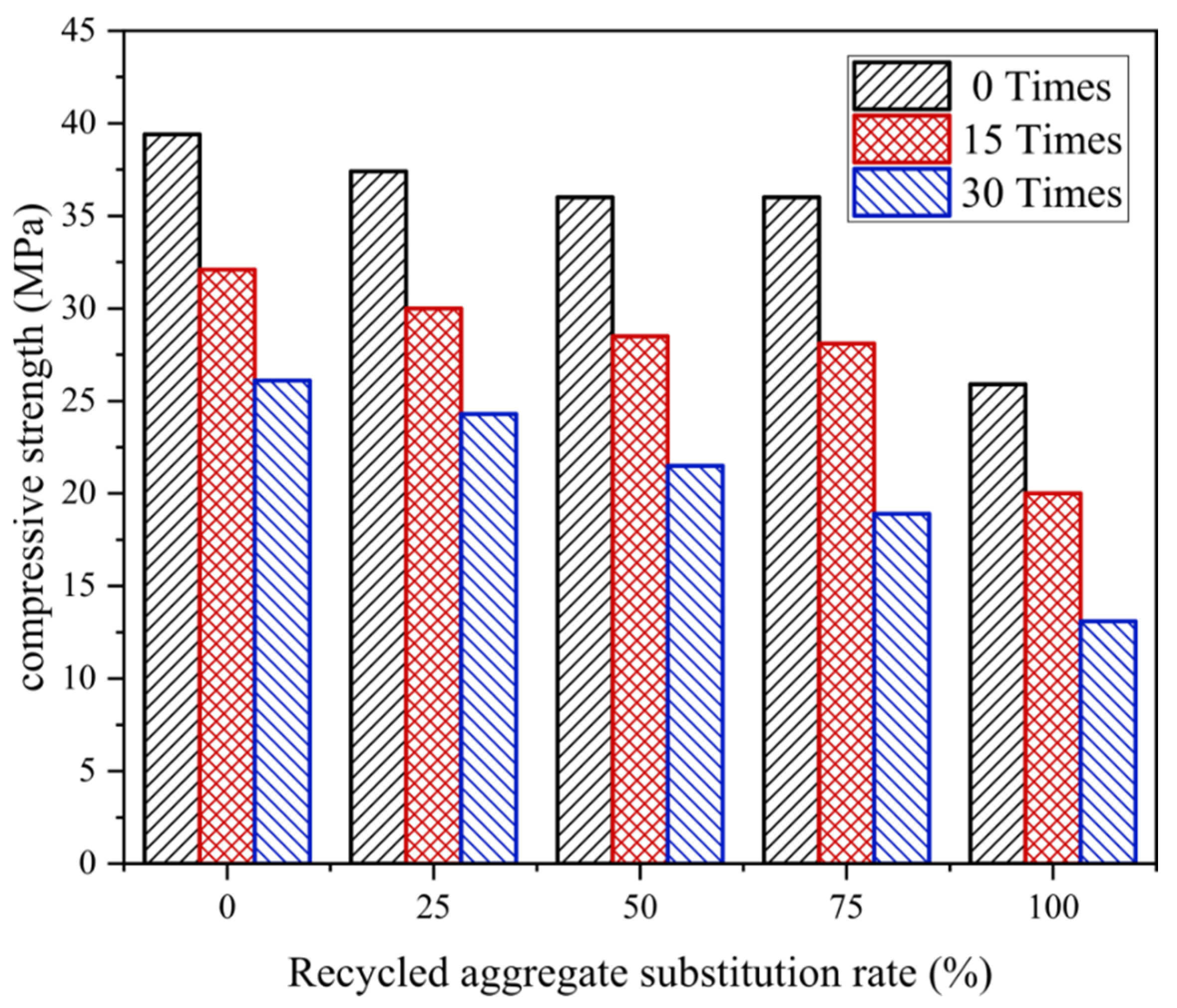
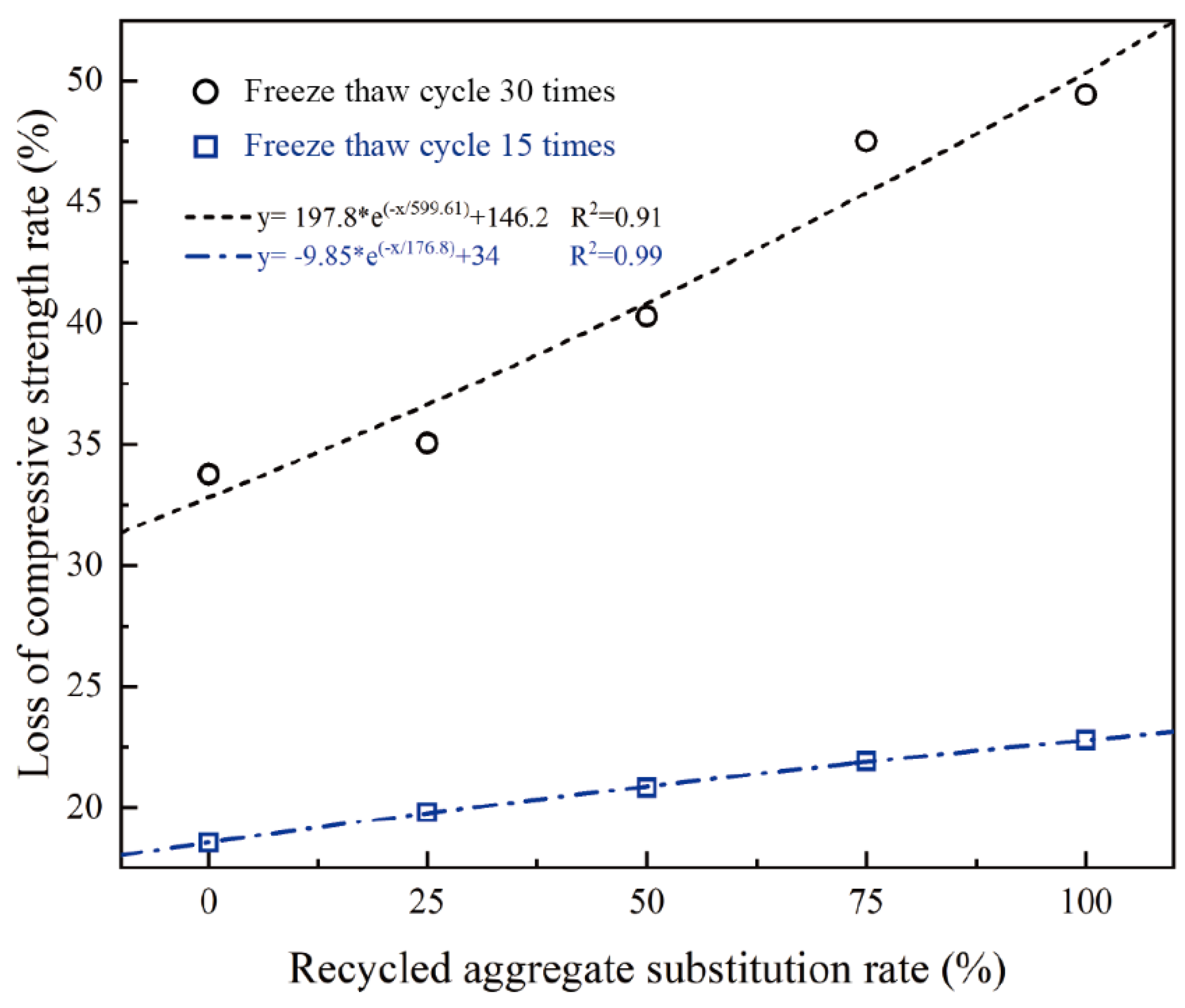
| CaO | SiO2 | Al2O3 | Fe2O3 | MgO | SO3 |
|---|---|---|---|---|---|
| 57.65 | 21.44 | 5.36 | 3.56 | 1.24 | 2.43 |
| Categories | Apparent Density (kg/m3) | Packing Density (kg/m3) | Indicators of Crushing (%) | 24 h Water Absorption (%) |
|---|---|---|---|---|
| Natural coarse aggregate | 2738 | 1541 | 7.3 | 0.97 |
| Recycled fine aggregate | 2840 | 1443 | 6 | 2.76 |
| Recycled coarse aggregate | 2514 | 1427 | 14.2 | 6.14 |
| Specimen Type | Water-to-Cement Ratio | Amount of Material in Recycled Concrete (kg/m−3) | |||||
|---|---|---|---|---|---|---|---|
| Cement | Water | Recycled Fine Aggregate | Coarse Aggregate | ||||
| Natural | Renewable | Replacement Rate (%) | |||||
| NC | 0 50 | 411.5 | 205.8 | 603.6 | 1207.1 | 0 | 0 |
| R25 | 0.50 | 411.5 | 205.8 | 603.6 | 905.3 | 301.8 | 25 |
| R50 | 0.50 | 411.5 | 205.8 | 603.6 | 603.5 | 603.5 | 50 |
| R75 | 0.50 | 411.5 | 205.8 | 603.6 | 301.8 | 905.3 | 75 |
| R100 | 0.50 | 411.5 | 210 | 610.8 | 0 | 1207.1 | 100 |
| Technical Index | Content (Mass)/% |
|---|---|
| Micro powder content | 1.51 |
| Clay lump | 0.64 |
| Water absorption rate | 4.24 |
| Needle-like particle content | 5 |
| Sulfide and sulfate content | 1.11 |
| Chloride content | 0.02 |
| Impurity content | 0.6 |
| Mass loss | 6.57 |
| Crushing index | 15 |
| Apparent density/(kg/m3) | 2391 |
| Void ratio | 47 |
| Concrete Type | Compatibility | ||
|---|---|---|---|
| Slump | Cohesive | Water Retention | |
| NC | 111 | A | A |
| R25 | 101 | B | B |
| R50 | 98 | A | B |
| R75 | 96 | A | A |
| R100 | 90 | A | B |
Disclaimer/Publisher’s Note: The statements, opinions and data contained in all publications are solely those of the individual author(s) and contributor(s) and not of MDPI and/or the editor(s). MDPI and/or the editor(s) disclaim responsibility for any injury to people or property resulting from any ideas, methods, instructions or products referred to in the content. |
© 2024 by the authors. Licensee MDPI, Basel, Switzerland. This article is an open access article distributed under the terms and conditions of the Creative Commons Attribution (CC BY) license (https://creativecommons.org/licenses/by/4.0/).
Share and Cite
Jierula, A.; Wu, C.; Fu, Z.; Niyazi, H.; Li, H. Experimental Study of Recycled Concrete under Freeze–Thaw Conditions. Materials 2024, 17, 3934. https://doi.org/10.3390/ma17163934
Jierula A, Wu C, Fu Z, Niyazi H, Li H. Experimental Study of Recycled Concrete under Freeze–Thaw Conditions. Materials. 2024; 17(16):3934. https://doi.org/10.3390/ma17163934
Chicago/Turabian StyleJierula, Alipujiang, Cong Wu, Zhixuan Fu, Hushitaer Niyazi, and Haodong Li. 2024. "Experimental Study of Recycled Concrete under Freeze–Thaw Conditions" Materials 17, no. 16: 3934. https://doi.org/10.3390/ma17163934
APA StyleJierula, A., Wu, C., Fu, Z., Niyazi, H., & Li, H. (2024). Experimental Study of Recycled Concrete under Freeze–Thaw Conditions. Materials, 17(16), 3934. https://doi.org/10.3390/ma17163934






